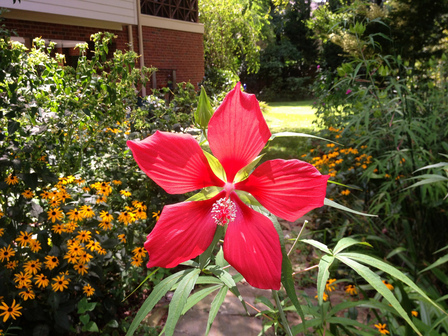|
The southern garden, going all the way back to antebellum days, has for so long been dominated by non native plants that the native plants now are more exotic.
Azalea, camellia, gardenia, elaeagnus, pyracantha, tea olive, English ivy, wisteria, fig vine, nandina, mophead hydrangea, pachysandra,, crape myrtle, rose of Sharon, winter daphne, mahonia, Confederate rose, Confederate jasmine, bearded iris, abelia, spirea - the list goes on and on. There is very little exotic any more about these common plants from other parts of the world. If you want exotic, how about fothergilla, button bush, Carolina allspice, Florida anise, loblolly bay, buckeye (any one of five), sourwood, black gum, sassafras, paw paw, sweet bay magnolia, sparkleberry, fringe tree, flame azalea, silky camellia, coral honeysuckle, ashe magnolia, wild ginger, may apple, trillium, may pop, mock orange, Kentucky coffee tree, milkweed, coral bells, indigo, coral bean, ageratum, possum haw, climbing hydrangea, snowbell, spice bush - again the list goes on and on, but few people have these plants in their gardens! When combined with common popular native plants like dogwood, magnolia, black eyed Susan, red bud, American holly, pine, sweet gum, tulip poplar, red maple, trumpet vine etc, it is clear that there are more than enough wonderful native plants to fill up any garden! Not that we need to ditch all of our wonderful camellias! But slowly, surely, we can add more and more natives over time. Not only are they beautiful, and oddly exotic, but it makes a lot of sense!
Gardening with native plants makes good practical sense for at least three reasons: 1) Water conservation: native plants are adapted to our hot sandy climate in Columbia and simply do not require as much water. This is good. 2) Ecosystem health: we do not always think of ecosystems in the urban or suburban environment but they exist, and they are either more or less healthy. Native insects, bird, and soil microorganisms for example thrive best in cooperation with native plants. Not only that but non natives tend also to be invasive - and often aggressively so, choking out native plants not only in the home garden but in woods and streams and forests. 3) Plant health and maintenance: native plants that are adapted to our local conditions require less care and require much less "help" in terms of insecticides or pesticides. 4) Because they are less common, native plants are interesting, and well, just plain cool. Having said all that I know that the very concept of "native" can be tricky, and I am not a zealot. The best way I know to communicate my views is in the following essay, "Lessons from Nanny." |
|
Native Is the New Exotic
And if they grew here for thousands of years without our help they might be a good idea...


